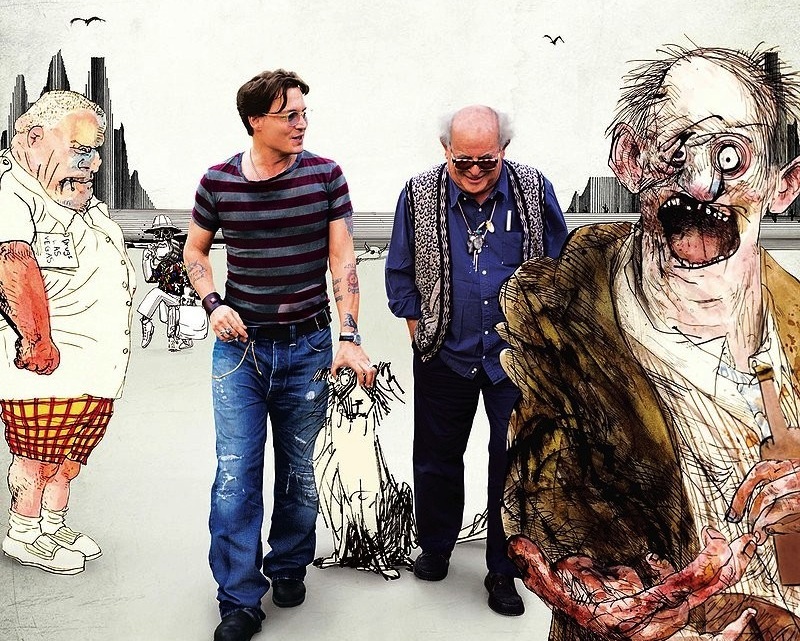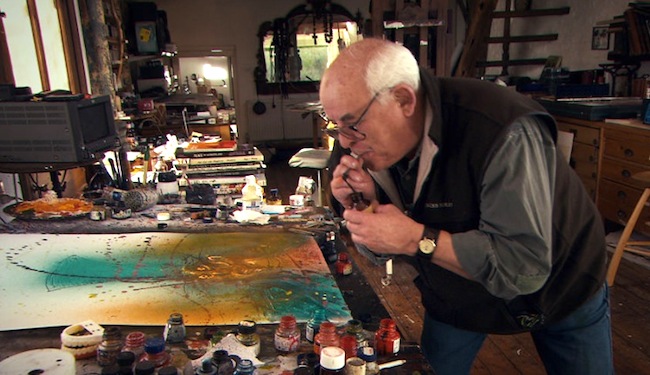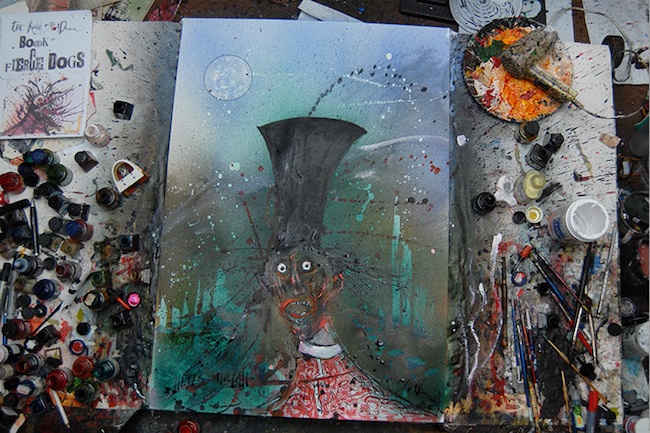Ralph Steadman is the last of the original Gonzo visionaries. Made over the course of fifteen years, Charlie Paul’s fascinating documentary, For No Good Reason, looks at the connection between life and art as seen by Steadman and explores his long-term relationships with counterculture luminaries such as Hunger S. Thompson and William S. Burroughs. The film is truly a visual feast, and includes detailed footage of Ralph Steadman’s unique process of making art. Steadman’s friend Johnny Depp appears on the scene to guide us through different periods of the British artist’s life. The film also features contributions from Terry Gilliam, Richard E. Grant, and others. I sat down with British director Charlie Paul and his wife, producer Lucy Paul, in Los Angeles to discuss this unusual and inspiring film.
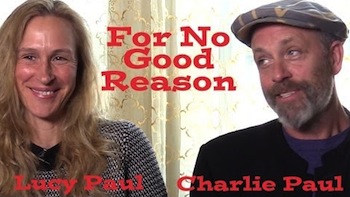 Danny Miller: I think the best documentaries make us rush home and start researching the subject on our own. That’s what happened to me after watching this film. I’d heard of Ralph Steadman but I knew little about the breadth of his amazing work.
Danny Miller: I think the best documentaries make us rush home and start researching the subject on our own. That’s what happened to me after watching this film. I’d heard of Ralph Steadman but I knew little about the breadth of his amazing work.
Lucy Paul: That’s great to hear since that was our main intention. You don’t want to lay it all out when you make a documentary like this, you want to inspire the audience to pursue their own interests and go find out more about the person.
How did you first meet Ralph Steadman?
Charlie Paul: In England, Ralph has always been this underground artist that everyone was aware of, but because he’s a very private man and his publications would only come out every two or three years, it was hard to find out much about him. I think I was in college when I read Fear and Loathing in Las Vegas and my eyes were opened to this fantastic synergy between art and literature. As an artist myself who was interested in the counterculture, I admired Ralph’s way of looking at the world. He’s been so great during his life and career waving the flag against bullies and injustice.
Lucy: I think Ralph’s art encapsulates subject matter that you are naturally drawn to — his message has always held a strong resonance for you.
Charlie: Absolutely. I had heard that Ralph kept a camera over his desk to film his work. I wrote him a letter and said something like, “Dear Ralph, I do the same thing as you — I film people making art.” And I got a letter back from him that said, “Dear boy, you don’t do the same thing as me at all!” (Laughs.) But then he invited me to come down and pay him a visit so I went to his amazing house in the country. We had a great conversation and as I was leaving I asked him if I could come back again. He said of course and then handed me this big box of videocassettes, I think there were about a hundred, and told me to have a look. I went home and watched the tapes and couldn’t believe what I saw. His whole archives including personal conversations with him and Hunter S. Thompson, a lot of stuff with William Burroughs, all sorts of things.
As a filmmaker, you must have been drooling.
Lucy: I was always so amazed by what happened after that first exchange. Why did this guy give you his box of tapes?
I’m sure it helped that you were an artist yourself. He must have trusted you right away on some deeper level.
Charlie: I think that’s right. If I’d been just a filmmaker looking to make a documentary, it never would have happened. When we first started filming, it was clear that I was not there to direct anything that happened in his studio.
“Can you do that again, Ralph? We didn’t quite get the splat right!”
Exactly. I knew that no matter what happened, if I wasn’t there at the right time, I wouldn’t get it. I never asked for anything. My goal for the film was to capture the essence of Ralph’s working process unencumbered by production schedules. That’s why the film took so long to make since it was completely driven by Ralph.
Did you ever think during all that time, “Okay, this is the year we need to wrap this thing up?” Or did it just have its own organic schedule?
Lucy: I saw right away in the early years that this was Charlie’s creative outlet — his way of exploring his creativity without the constraints of clients or a budget . It was his creative nourishment. We didn’t know back then what the end product would be, but then the momentum kind of snowballed and Charlie got to the point where he felt he needed a crew for certain things he wanted to shoot. That’s when I started writing down what this was costing us! (Laughs.) About five or six years ago, it became apparent that we had some incredible footage and that there was a film to be made. We started to be a little more structured about it and hired an editor.
Charlie: Over the years there have been ebbs and flows and outside events that affected the film. When Hunter shot himself, Ralph went to a very dark place for a long time. We didn’t work on the film very much during that period. I’d still go down there but we’d just talk about Hunter and look at pictures. Because of the way we were doing things, there was no way I would ever say, “Get over it, Ralph, we need to get back to the film!”
Did he ever stop you from shooting anything when you were there because he just wasn’t into it that day?
To be perfectly honest, I think Ralph really enjoyed the process of me coming down and contributing to his working day. Sometimes his wife would call me and say, “He’s a bit blue today, why don’t you come down and do something in the studio?” We definitely developed a close personal relationship in addition to our working relationship.
Lucy: I think you were beautifully sensitive — you never pushed him. If you knew there was something you wanted to get but he didn’t want to talk about it, you’d just leave it alone and approach him again a month later.
Apart from everything else, the film is a technical marvel. I loved the different film stocks you used.
Charlie: The physicality of the film changed a lot over time. When I started, there was no digital. Many people may not notice, but we use every film type, every kind of film stock: 35mm, 16mm, Super 8, HD, DV, and so on. If I was filming in the context of something that happened in 1970, I’d use 1970 film stock! Very old film is incredibly robust. I used some film that was so old people wouldn’t even believe it would still record images. But it produces amazing stuff.
Wow. These days I would think it would be even hard to find labs to process that film.
It is! I couldn’t have made this film today. But it adds so much to the texture — I treated film stocks like an artist would treat his materials. But there were lots of challenges. I remember I found this little tape from Ralph’s old answering machine that included all these messages of Hunter ringing him up (“Ralph! What are you doing?!”). But even finding a machine to play that tape was a huge deal. My studio is now littered with a lot of old desolate rubbish!
Lucy: That’s the fun of it!
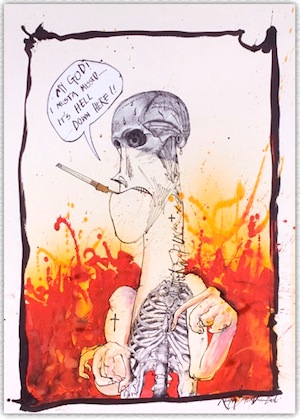 One thing about Ralph that I found so riveting was the period when he was doing those very incendiary political cartoons. They’re so great but they seem pretty shocking to our eyes today. I kept wondering if those cartoons landed him on any FBI lists back in the day.
One thing about Ralph that I found so riveting was the period when he was doing those very incendiary political cartoons. They’re so great but they seem pretty shocking to our eyes today. I kept wondering if those cartoons landed him on any FBI lists back in the day.
Charlie: No, I don’t think so. But you’re right — if Ralph was doing now what he did then, he probably would never be allowed back in America.
And there’d be some Homeland Security SWAT team descending on his studio!
I’m fascinated by how these things have changed over the years. I don’t think most people worried back then that their visa was going to be revoked, they just said what they felt they had to say. Now everyone is so scared. I don’t think people like him and Hunter could exist today.
It’s sad because we think we’re so evolved now, but in some ways we’re going backwards in terms of political expression.
Yes, there’s a lot of fear about the repercussions of speaking out. I hope the film champions the idea that you people say what you want to say. One of the things I most love about Ralph’s art is that he could say so much more with it than if he were just using words. You see an image like the one of Nixon melting and you realize how much a drawing can convey.
I also found myself very inspired just watching him create art. When he kept working on that one painting when Johnny Depp was in the studio, and he was adding all those layers, there were times I wanted to shout, “Stop! You’re ruining it!” but he would continue on, just following his vision and not worrying about any “mistakes.”
Yes. Ralph always says that there’s no such thing as a mistake — a mistake is just an opportunity to do something else — something new. Ralph has no fear of taking his art to the next stage.
Lucy: I think that philosophy could be beneficial to whatever field you’re working in.
Charlie: I would love for people who see this film to leave the theater and feel that they can use their voice the way Ralph does. I want to enourage people to go out there and make a mess. To me, the most rewarding thing about the film is the possibility of inspiring the next generation of Ralph Steadmans.

